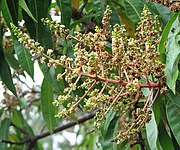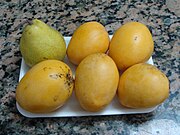Etymology
The name mango is ultimately either from the Kodagu mange, the Malayalam manga, or the Tamil mangai, and was loaned into Portuguese in the early 16th century as manga, and from Portuguese passed into English. The ending in -o appears in English and is of unclear origin.[2]
[edit] Description
Mango trees (Mangifera indica) reach 35-40 m in height, with a crown radius of 10 m. The leaves are evergreen, alternate, simple, 15-35 cm long and 6-16 cm broad; when the leaves are young they are orange-pink, rapidly changing to a dark glossy red, then dark green as they mature. The flowers are produced in terminal panicles 10-40 cm long; each flower is small and white with five petals 5-10 mm long, with a mild sweet odor suggestive of lily of the valley. The fruit takes from three to six months to ripen.
The ripe fruit is variable in size and color, and may be yellow, orange, red or green when ripe, depending on the cultivar. When ripe, the unpeeled fruit gives off a distinctive resinous sweet smell. In its center is a single flat oblong seed that can be fibrous or hairy on the surface, depending on the cultivar. Inside the seed coat 1-2 mm thick is a thin lining covering a single embryo, 4-7 cm long, 3-4 cm wide, and 1 cm thick.
Cultivation and uses
Mangoes have been cultivated in the Indian subcontinent for thousands of years[3] and reached East Asia between the 5th-4th century BC. By the 10th century AD, they were transported to East Africa[3] and subsequently introduced to Brazil, West Indies and Mexico, where climate allows its appropriate growth.[3] The 14th century Muslim traveler, Ibn Battuta, reported it at Mogadishu.[4]
Mango is now cultivated as a fruit tree in frost-free tropical and warmer subtropical climates like that of the Indian subcontinent; nearly half of the world's mangoes are cultivated in India alone.[5][6][7]
Other regions where mango is cultivated include North, South and Central America, the Caribbean, south and central Africa, Australia, China, Pakistan and Southeast Asia. It is easily cultivated yielding more than 1,000 cultivars, ranging from the "turpentine mango" (named for its strong taste of turpentine, which according to the Oxford Companion to Food some varieties actually contain) to the huevos de toro ("eggs of the bull", a euphemism for "bull's testicles", referring to the shape and size).
Though India is the largest producer of mangoes in the world, it accounts for less than one percent of the global mango trade.[10]
Dwarf or semi-dwarf varieties serve as ornamental plants and can be grown in containers.
Diseases
Food
A ripe mango is sweet, with a unique taste. The texture of the flesh varies between cultivars, some having a soft, pulpy texture similar to an over-ripe plum, while others have firmer flesh like a cantaloupe or avocado. In some cultivars, the flesh has a fibrous texture.
Mangoes are used in chutney; Western recipes are often sweet and so use ripe mangoes, but in the Indian subcontinent is usually made with sour, unripe mangoes and hot chilis or limes. In India, ripe mango is often cut into thin layers, desiccated, folded, and then cut. These bars, known as amavat or halva in Hindi, are similar to dried guava fruit bars available in Colombia. In many parts of India, people eat squeezed mango juice (called Ras) on variety of bread items and is part of the meal rather than a dessert. Unripe mangoes (which are extremely sour) are eaten with salt, and in regions where food is hotter, with salt and chili.
In Kerala, ripe mango are used in a dish called mambazha kaalan.
In Maharashtra, Muramba (a kind of preserve, made from jaggery and mango) and Aamrus (Pulp/Thick Juice made of mangoes, with a bit of sugar if needed and milk at times) is famous. They can be enjoyed with poories and polies, like jam.
The fruit is also used in a variety of cereal products, in particular muesli and oat granola.
In the Philippines, unripe mango is eaten with bagoong. Dried strips of sweet, ripe mango are also popular, with those from Cebu exported worldwide. Guimaras produces a delicious mango.
In Mexico, mango is used to make juices, smoothies, ice cream, fruit bars, raspados, aguas frescas, pies and sweet chili sauce, or mixed with chamoy, a sweet and spicy chili paste. It is popular on a stick or also as a main ingredient in fresh fruit combinations.
Pieces of mango can be mashed and used as a topping on ice cream or blended with milk and ice as milkshakes. In Thailand and other South East Asian countries, sweet glutinous rice is flavored with coconut then served with sliced mango as a dessert.
In other parts of South-east Asia, mangoes are pickled with fish sauce and rice vinegar.
In Taiwan, mango is a topping that can be added to shaved ice along with condensed milk.
Dried unripe mango is known as amchur (sometimes spelled amchoor) in India and ambi in Urdu. Amb is a Sindhi, Aamba is a Marathi and aam is a Hindi/Urdu/Punjabi word for mango.
The sweet bell pepper (capsicum) was once known as mango in parts of the United States.[11]
Nutrient and antioxidant properties
Mango is rich in a variety of phytochemicals and nutrients that qualify it as a model "superfruit", a term used to highlight potential health value of certain edible fruits. The fruit is high in prebiotic dietary fiber, vitamin C, polyphenols and carotenoids.[12]
Mango contains essential vitamins and dietary minerals. The antioxidant vitamins A, C and E comprise 25%, 76% and 9% of the Dietary Reference Intake (DRI) in a 165 g serving. Vitamin B6 (pyridoxine, 11% DRI), vitamin K (9% DRI), other B vitamins and essential nutrients such as potassium, copper and 17 amino acids are at good levels. Mango peel and pulp contain other phytonutrients, such as the pigment antioxidants - carotenoids and polyphenols - and omega-3 and -6 polyunsaturated fatty acids.
The edible mango peel has considerable value as a source of dietary fiber and antioxidant pigments.[13][14][15] Contained within the peel and pulp are rich contents of polysaccharides as fiber sources, especially starch and pectins.[16][17]
Antioxidants of the peel and pulp include carotenoids, such as the provitamin A compound, beta-carotene, lutein and alpha-carotene,[18] polyphenols[19][20] such as quercetin, kaempferol, gallic acid, caffeic acid, catechins, tannins, and the unique mango xanthone, mangiferin,[21] any of which may counteract free radicals in various disease mechanisms as revealed in preliminary research.[22][23] Contents of these phytochemicals and nutrients appear to vary across different mango species.[24] Up to 25 different carotenoids have been isolated from mango pulp, the densest content for which was beta-carotene accounting for the yellow-orange pigmentation of most mango species.[25] Peel and leaves also have significant content of polyphenols, including xanthones, mangiferin and gallic acid.[26]
The mango triterpene, lupeol[27] is an effective inhibitor in laboratory models of prostate and skin cancers[28].[29][30] An extract of mango branch bark called Vimang, isolated by Cuban scientists, contains numerous polyphenols with antioxidant properties in vitro[31] and on blood parameters of elderly humans.[32]
The pigment euxanthin, known as Indian yellow, is often thought to be produced from the urine of cows fed mango leaves; the practice is described as having been outlawed in 1908 due to malnutrition of the cows and possible urushiol poisoning.[33] One author[34] claims these descriptions of the pigment's origin rely on a single anecdotal source and Indian legal records do not mention such a practice being outlawed.
| Mango, raw Nutritional value per 100 g (3.5 oz) | ||||||||||||||||||||||||||||||||||||||||
|---|---|---|---|---|---|---|---|---|---|---|---|---|---|---|---|---|---|---|---|---|---|---|---|---|---|---|---|---|---|---|---|---|---|---|---|---|---|---|---|---|
| Energy 70 kcal 270 kJ | ||||||||||||||||||||||||||||||||||||||||
| ||||||||||||||||||||||||||||||||||||||||
| Percentages are relative to US recommendations for adults. Source: USDA Nutrient database | ||||||||||||||||||||||||||||||||||||||||
Nutrient data in the text are for a 165 g serving as presented by Nutritiondata.com whereas the table presents data for a 100 g serving.









Tidak ada komentar:
Posting Komentar